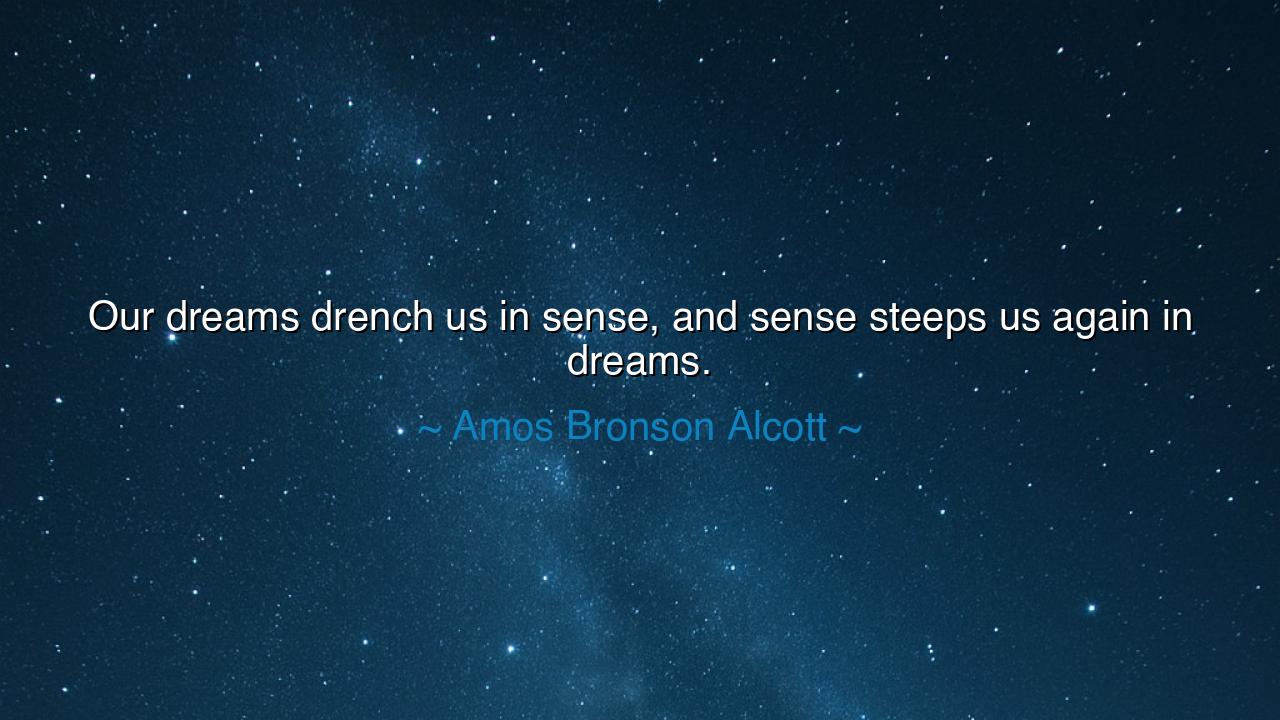
Our dreams drench us in sense, and sense steeps us again in






The Circle of Dream and Reality
From the mind of the transcendental sage Amos Bronson Alcott, mentor to thinkers like Emerson and father to the beloved writer Louisa May Alcott, comes this luminous reflection: “Our dreams drench us in sense, and sense steeps us again in dreams.” These words are not mere poetry—they are the revelation of a cycle as eternal as breath itself. In them, Alcott unveils the sacred rhythm between the inner world and the outer world, between what we imagine and what we perceive. The dream and the world are not enemies, he tells us; they are mirrors, endlessly reflecting one another. We dream, and our dreams color reality. We awaken, and our experiences enrich the next dream. Thus life becomes a continuous dialogue between vision and experience, between the soul and the senses.
The meaning of this quote lies in its understanding of how the human spirit moves through creation. Dreams are not only the images of sleep, but the aspirations and visions that arise from within—the higher currents of imagination that guide our waking lives. They “drench us in sense,” meaning they pour into our consciousness, shaping how we see and feel the world. When we dream, our inner life spills outward; when we act and perceive, our senses drink from the world and steep the soul once more in inspiration. This sacred exchange is the source of all art, all progress, all meaning—for without dreams, our senses grow dull, and without sense, our dreams become hollow.
The origin of these words emerges from the transcendentalist movement of the 19th century—a philosophy born among poets and mystics who believed that divine truth speaks through both nature and imagination. Alcott, a man of deep moral and spiritual conviction, saw life not as a battle between spirit and matter, but as their marriage. He believed that every experience of the senses—every sight, sound, and sensation—was a lesson written by the universe to awaken the soul. Likewise, he saw dreams as revelations, carrying us beyond the limits of reason into the infinite realm of possibility. In his view, to live fully is to walk in both worlds at once—to dream consciously and to perceive with reverence.
This truth can be seen in the life of Leonardo da Vinci, the Renaissance genius who embodied the union of dream and sense. Leonardo’s sketches of flying machines and his studies of the human form were not opposites but reflections of one another: his dreams of flight inspired his observations of birds; his senses, sharpened by study, deepened his visions. He lived in that sacred cycle where the dream feeds perception, and perception feeds the dream. Through him, Alcott’s words find living proof: the man who dreams with his eyes open transforms the world into a canvas of wonder.
There is also a quieter wisdom in Alcott’s saying—a reminder that our inner life and outer life are not to be divided. In modern times, men often fall to one extreme or the other: some dream without acting, others act without dreaming. But the soul thrives only in balance. To dream is to ignite the fire of creation; to sense is to temper it with truth. The one without the other leads to despair—dreams untethered from reality become delusion, and senses devoid of vision become monotony. Thus, the wise man learns to let his dreams guide his senses, and his senses refine his dreams, until both serve the unfolding of his destiny.
The ancient philosophers knew this as well. Plato spoke of the “world of forms,” where the eternal ideas dwell, and the visible world, where those ideas take shape. What Alcott calls “dreams and sense,” Plato called “form and shadow.” Both are essential, for the shadow without form is meaningless, and the form without shadow is unseen. The dreamer who understands this balance becomes a creator—he moves through the world as both artist and philosopher, transforming the ordinary into the divine. Every sound becomes music, every face becomes a story, every moment becomes an illustration in the book of the soul.
Therefore, O seeker of wisdom, let this be your lesson: live in the rhythm of dream and sense. When you dream, do not flee from the world—draw from it, let its textures and colors fill your imagination. When you act and perceive, do not forget to bring your soul’s vision into each moment. Treat your daily life as sacred material, and your imagination as the loom that weaves it into meaning. Record your dreams, reflect on your experiences, and let each nourish the other until both are whole. This is the art of being truly alive: to let the unseen and the seen, the inner and the outer, flow into one another like light and water, each enriching the other.
And when your days have passed and your life’s work is done, you will see that you have lived as Alcott envisioned—not divided between the dream and the real, but dwelling in the eternal current that unites them. For those who learn this truth find peace, creativity, and wisdom. Their lives become the very thing Alcott describes: a book written by the soul, illustrated with dreams and illuminated by sense, each page shining with the harmony of the inner and outer worlds.






AAdministratorAdministrator
Welcome, honored guests. Please leave a comment, we will respond soon